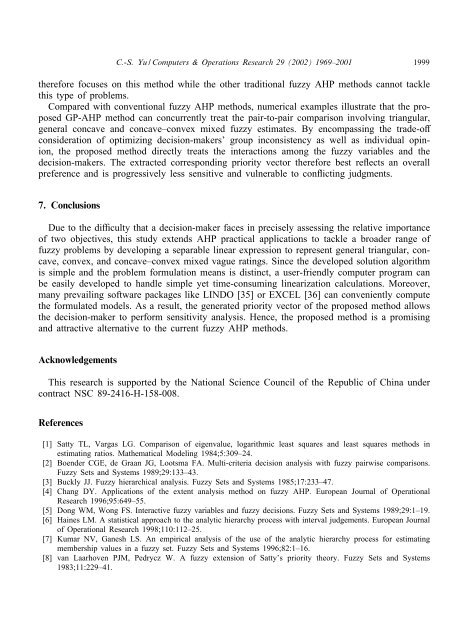A GP-AHP method for solving group decision-making fuzzy AHP ...
A GP-AHP method for solving group decision-making fuzzy AHP ...
A GP-AHP method for solving group decision-making fuzzy AHP ...
Create successful ePaper yourself
Turn your PDF publications into a flip-book with our unique Google optimized e-Paper software.
C.-S. Yu / Computers & Operations Research 29 (2002) 1969–2001 1999<br />
there<strong>for</strong>e focuses on this <strong>method</strong> while the other traditional <strong>fuzzy</strong> <strong>AHP</strong> <strong>method</strong>s cannot tackle<br />
this type of problems.<br />
Compared with conventional <strong>fuzzy</strong> <strong>AHP</strong> <strong>method</strong>s, numerical examples illustrate that the proposed<br />
<strong>GP</strong>-<strong>AHP</strong> <strong>method</strong> can concurrently treat the pair-to-pair comparison involving triangular,<br />
general concave and concave–convex mixed <strong>fuzzy</strong> estimates. By encompassing the trade-o<br />
consideration of optimizing <strong>decision</strong>-makers’ <strong>group</strong> inconsistency as well as individual opinion,<br />
the proposed <strong>method</strong> directly treats the interactions among the <strong>fuzzy</strong> variables and the<br />
<strong>decision</strong>-makers. The extracted corresponding priority vector there<strong>for</strong>e best re ects an overall<br />
preference and is progressively less sensitive and vulnerable to con icting judgments.<br />
7. Conclusions<br />
Due to the di culty that a <strong>decision</strong>-maker faces in precisely assessing the relative importance<br />
of two objectives, this study extends <strong>AHP</strong> practical applications to tackle a broader range of<br />
<strong>fuzzy</strong> problems by developing a separable linear expression to represent general triangular, concave,<br />
convex, and concave–convex mixed vague ratings. Since the developed solution algorithm<br />
is simple and the problem <strong>for</strong>mulation means is distinct, a user-friendly computer program can<br />
be easily developed to handle simple yet time-consuming linearization calculations. Moreover,<br />
many prevailing software packages like LINDO [35] or EXCEL [36] can conveniently compute<br />
the <strong>for</strong>mulated models. As a result, the generated priority vector of the proposed <strong>method</strong> allows<br />
the <strong>decision</strong>-maker to per<strong>for</strong>m sensitivity analysis. Hence, the proposed <strong>method</strong> is a promising<br />
and attractive alternative to the current <strong>fuzzy</strong> <strong>AHP</strong> <strong>method</strong>s.<br />
Acknowledgements<br />
This research is supported by the National Science Council of the Republic of China under<br />
contract NSC 89-2416-H-158-008.<br />
References<br />
[1] Satty TL, Vargas LG. Comparison of eigenvalue, logarithmic least squares and least squares <strong>method</strong>s in<br />
estimating ratios. Mathematical Modeling 1984;5:309–24.<br />
[2] Boender CGE, de Graan JG, Lootsma FA. Multi-criteria <strong>decision</strong> analysis with <strong>fuzzy</strong> pairwise comparisons.<br />
Fuzzy Sets and Systems 1989;29:133–43.<br />
[3] Buckly JJ. Fuzzy hierarchical analysis. Fuzzy Sets and Systems 1985;17:233–47.<br />
[4] Chang DY. Applications of the extent analysis <strong>method</strong> on <strong>fuzzy</strong> <strong>AHP</strong>. European Journal of Operational<br />
Research 1996;95:649–55.<br />
[5] Dong WM, Wong FS. Interactive <strong>fuzzy</strong> variables and <strong>fuzzy</strong> <strong>decision</strong>s. Fuzzy Sets and Systems 1989;29:1–19.<br />
[6] Haines LM. Astatistical approach to the analytic hierarchy process with interval judgements. European Journal<br />
of Operational Research 1998;110:112–25.<br />
[7] Kumar NV, Ganesh LS. An empirical analysis of the use of the analytic hierarchy process <strong>for</strong> estimating<br />
membership values in a <strong>fuzzy</strong> set. Fuzzy Sets and Systems 1996;82:1–16.<br />
[8] van Laarhoven PJM, Pedrycz W. A<strong>fuzzy</strong> extension of Satty’s priority theory. Fuzzy Sets and Systems<br />
1983;11:229–41.









